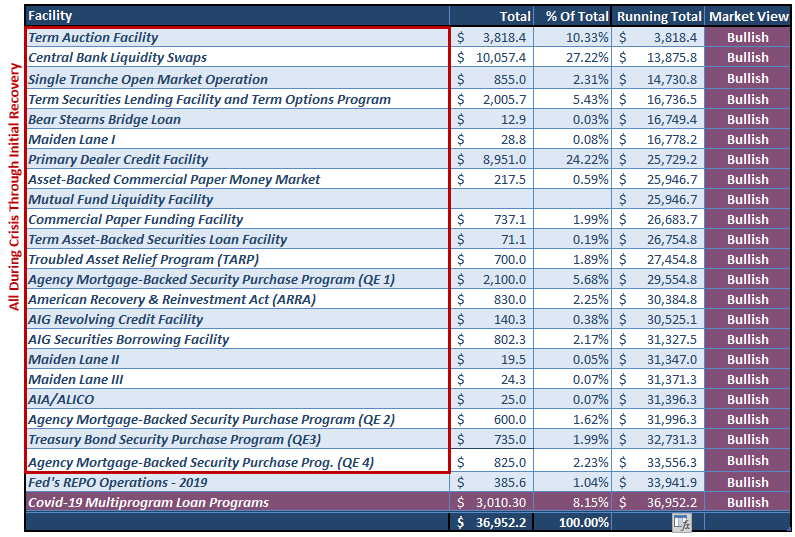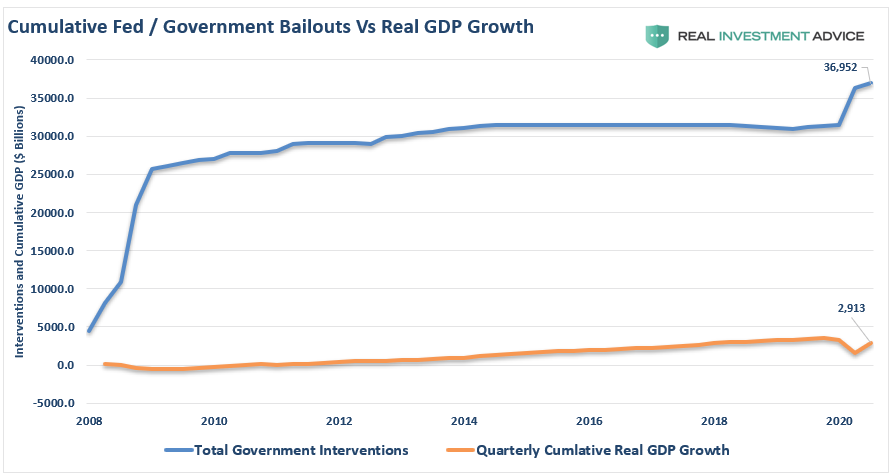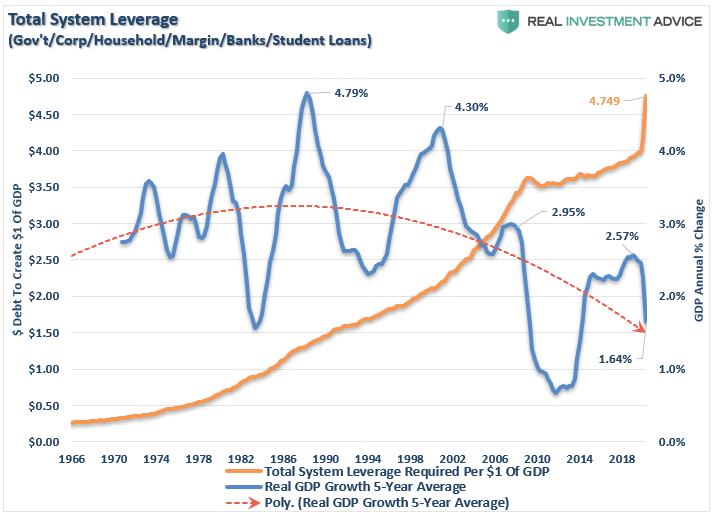Es bleibt keine andere Wahl als … zu drucken
Diese Woche haben wir wieder mal Schuldenwochen bei bto. Nach den – nicht überraschenden – Zahlen des Institute of International Finance IFF und der gestrigen Mahnung von Hans-Werner Sinn vor den Folgen für die Inflation werfen wir noch einmal einen Blick darauf, wie wir hierhergekommen sind. Genau: über fast 40 Jahre asymmetrische Geldpolitik der Notenbanken. Nun können die Fed und alle anderen nicht mehr aussteigen. Stimulus für immer?
So zumindest diese interessante Argumentation:
- “To understand the problem, we have to go back to the beginning. As we noted in our article on financial rescues, the bailouts and stimulus programs started in 2008 when the Federal Reserve intervened with the insolvency of Bear Stearns. They haven’t stopped since.” – bto: Falsch, der Beginn war 1987. Dennoch stimmt es natürlich, dass die Zahlen seit 2009 wirklich beeindruckend sind – und vor allem mit so einer geringen realwirtschaftlichen Wirkung:

Quelle: Real Investment Advice
So noch einmal in einer grafischen Aufbereitung. Ein Bild sagt bekanntlich mehr als 1000 Worte und diesmal stimmt das wirklich:

Quelle: Real Investment Advice
- Die Folge: “The trap the Federal Reserve has stumbled into is that it continues to require more interventions to sustain lower rates of economic growth. Whenever the Fed withdraws interventions, economic growth collapses.” – bto: Das führt zu immer höheren Schulden und einer noch anfälligeren Wirtschaft.
- “Such is why Fed Chairman Jerome Powell has repeatedly pressed for more ‘fiscal’ support from Congress. Without more debt issuance, the Federal Reserve’s ability to ‘monetize’ bonds to provide ‘monetary stimulus’ to the markets is limited.” – bto: So ist es. Es ist die Bereitschaft, den Ansätzen von MMT zu folgen. Zu 100 Prozent.
- “In theory, boosting asset markets should increase consumer confidence and create a ‘trickle-down’ effect on the economy. (…) Since 2009, the raw increase in just the Fed’s balance sheet, excluding all the other interventions in the table above, was 438 %. During that same time frame, the S&P 500 increased by 199.94 % and GDP just 21.24 %.” – bto: was nicht überraschen kann. Warum demonstriert man nicht dagegen?
- “The question that plagues Central Bankers globally is why higher economic growth rates, and ultimately inflation, fail to appear. (…) there is a long historical correlation between increasing debts and lower economic growth rates.” – bto: Und wir wissen auch, warum: Zombifizierung, vorgezogener Konsum, Spekulation statt Investition … Die Folgen schön zusammengefasst in diesem Chart:

Quelle: Real Investment Advice
- “As stated, the Federal Reserve is in a trap from which there is no exit. As Former Fed Governor Randall Kroszner recently said: ‘The big debts that governments are racking up are going to make it difficult for central banks to raise rates when they feel the need to do so because that will increase borrowing costs.’ In an economy laden by $75 Trillion in debt, a record number of ‘Zombie’ companies kept alive only by low borrowing costs, and a near-record number of companies with negative equity, higher rates are a ‘death knell.’” – bto: weshalb weder die Fed noch die EZB oder eine andere der maßgeblichen Notenbanken auf die Bremse gehen kann, wie auch Hans-Werner Sinn richtig erkannt hat.
- “Even Former Bank of England policymaker Paul Tucker agreed that the financial markets have come to expect periodic support from central banks. ‘I wait, longing for a central banker to do for financial stability what Paul Volcker did for inflation, which is to break that psychology that you, the capitalist markets, are actually utterly dependent on the Federal Reserve and other central banks, propping up prices come what may.’” – bto: Das ist meines Erachtens undenkbar, weil ein Crash der Assetpreise die Wirtschaft in die Depression stürzt.
- “With the entirety of the financial ecosystem now more heavily levered than ever, the ‘instability of stability’ is now the most significant risk. The ‘stability/instability paradox’ assumes that all players are rational, and such rationality implies avoidance of destruction. In other words, all players will act rationally, and no one will push ‘the big red button.’ The Fed is highly dependent on this assumption as it provides the ‘room’ needed, after more than 10-years of the most unprecedented monetary policy program in U.S. history, to try and navigate the risks that have built up in the system. The Fed is dependent on ‘everyone acting rationally.’ Unfortunately, that has never been the case.” – bto: Klartext, es kommt zu weiteren Krisen mit noch mehr Interventionsbedarf.
Fazit: Das Problem kommt dann, wenn die Märkte die Risiken wieder wahrnehmen und die Fed nicht mehr ernsthaft agieren kann. Dieser Punkt mag noch nicht da sein, aber er nähert sich.
→ realinvestmentadvice.com: „Is The Fed Stuck With “Forever Stimulus”?“, 13. November 2020







